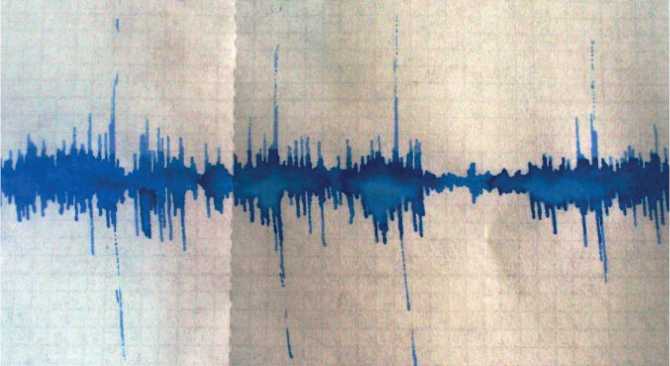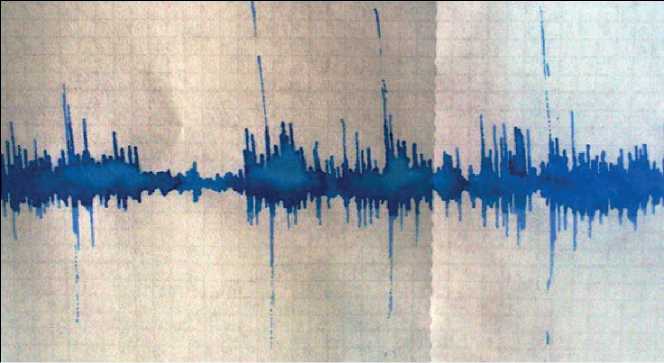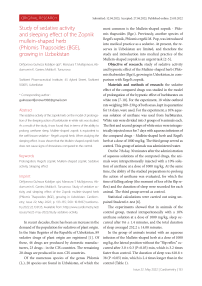Study of sedative activity and sleeping effect of the Zopnik mullein-shaped herb (Phlomis Thapsoides (BGE), growing in Uzbekistan
Автор: Kobiljon Q.O.G., Mullajonova M.T., Ganiev A.K., Tursunova M.K.
Журнал: Cardiometry @cardiometry
Рубрика: Original research
Статья в выпуске: 22, 2022 года.
Бесплатный доступ
The sedative activity of the zopnik herb on the model of prolongation of the sleeping action of barbiturate in white rats was studied. As a result of the study, it was found that, in terms of the ability to prolong urethane sleep, Mullein-shaped zopnik is equivalent to the well-known sedative - Regel’s zopnik herb. When studying the sleeping effect, it was shown that the Mullein-shaped zopnik herb does not cause signs of drowsiness compared to the control.
Prolongation, regel's zopnik, mullein-shaped zopnik, sedative activity, sleeping effect
Короткий адрес: https://sciup.org/148324413
IDR: 148324413 | DOI: 10.18137/cardiometry.2022.22.133135
Текст научной статьи Study of sedative activity and sleeping effect of the Zopnik mullein-shaped herb (Phlomis Thapsoides (BGE), growing in Uzbekistan
Imprint
Orifjonova Gulnoza Kobiljon qizi, Manzura T. Mullajonova, Ab-dumumin K. Ganiev, Malika K. Tursunova. Study of sedative activity and sleeping effect of the Zopnik mullein-shaped herb (Phlomis Thapsoides (BGE), growing in Uzbekistan. Cardiom-etry; Issue 22; May 2022; p. 133-135; DOI: 10.18137/cardiome-try.2022.22.133135; Available from: issues/no22-may-2022/study-sedative-activity
In recent decades, there has been an increase in the demand of the population for sedatives of plant origin. In the State Register of the Republic of Uzbekistan, 89 sedative drugs of plant origin are registered [1]. Of these, 46 drugs are produced by domestic manufacturers, 23 drugs - in the CIS countries. The remaining 20 drugs are produced in non-CIS countries.
Of the numerous species of the genus Phlomis (L.), 20 species are found in Uzbekistan, of which the most common is the Mullein-shaped zopnik - Phlo-mis thapsoides (Bge.). Previously, another species of Regel’s zopnik, Phlomis regelii M. Pop, was introduced into medical practice as a sedative. At present, the reserves in Uzbekistan are limited, and therefore the study and introduction into medical practice of the Mullein-shaped zopnik is an urgent task [2-5].
Objective of research: study of sedative activity and hypnotic effect of the Mullein-shaped herb (Phlo-mis thabsoides (Bge)), growing in Uzbekistan, in comparison with Regel’s zopnik.
Materials and methods of research: the sedative effect of the compared drugs was studied in the model of prolongation of the hypnotic effect of barbiturates on white rats [7-10]. For the experiment, 18 white outbred rats weighing 200–230 g of both sexes, kept in quarantine for 14 days, were used. For the experiment, a 10% aqueous solution of urethane was used from barbiturates. White rats were divided into 3 groups of 6 animals each. The first and second groups of white mice were intragas-trically injected once for 7 days with aqueous infusions of the compared drugs - Mullein-shaped herb and Regel’s herb at a dose of 1000 mg/kg. The third group served as control. This group of animals was administered water.
On the 7th day, 30 minutes after the administration of aqueous solutions of the compared drugs, the animals were intraperitoneally injected with a 10% solution of urethane at a dose of 1000 mg/kg. At the same time, the ability of the studied preparations to prolong the action of urethane was evaluated, for which the time of falling asleep (the moment of loss of the flip reflex) and the duration of sleep were recorded for each animal. The third group served as control.
Statistical calculations were carried out using unpaired Student’s t-test [6].
The experiments showed that in animals of the control group, treated intraperitoneally with a 10% urethane solution at a dose of 1000 mg/kg, sleep occurred after 9.6 ± 1.4 minutes, and the total duration of sleep averaged 252.2 ± 14.08 minutes.
In the group of animals treated with an aqueous infusion of the Mullein-shaped herb at a dose of 1000 mg/kg, the lateral position without the “flip reflex” occurred after 3.0 ± 0.3 (P<0.05) min, which is 3.2 times faster than control. The duration of sleep was 610.8 ± 38 (P <0.05) min, which is 2.4 times longer than in the control (Table 1).
Table 1
The sedative effect of the Regel’s zopnik herb (M ± m)
|
Weight of rats, g |
Urethane dose, 10% mg/ kg solution |
Dose of the drug mg/kg |
Latent Time of falling asleep, min |
Sleep duration, min |
|
Control group, water |
||||
|
214.7 ± 11.17 |
1000 |
- |
9.6 ± 1.4 |
252.2 ± 14.08 |
|
Mullein-shaped zopnik |
||||
|
218.7 ± 9.07 |
1000 |
1000 |
3.0 ± 0.3 Р<0.05 |
610.8 ± 38 Р<0.05 |
|
Regel’s zopnik herb |
||||
|
219.3 ± 8.9 |
1000 |
1000 |
2.8 ± 0.2 Р<0.05 |
621.2 ± 33.5 Р<0.05 |
The presence of a hypnotic effect in the Mullein-shaped herb was studied by the ability to influence the motor activity of white mice in comparison with the Regel’s zopnik herb. The hypnotic effect of the drug in this model manifests itself as inhibition of the motor activity of white mice with low mobility, lethargy, weakening of orientation reactions.
The experiment was carried out on 18 white mice weighing 20–23 g. The animals were divided into 3
groups of 6 animals each. From the compared drugs, water infusions were prepared at the rate of 1 g + 50 ml of water and administered as follows:
group 1 (control) - purified water;
group 2 (experiment) - infusion of the Mullein-shaped herb in a volume of 0.5 ml;
group 3 (experiment) - infusion of the Regel’s zop-nik in a volume of 0.5 ml.
After 15-20 minutes, the animals were placed in a chamber for recording motor activity. Motor activity was recorded for 30 minutes (orientation reflex).
Results and discussion: When studying the hypnotic effect of the compared drugs, it was found that with a single intragastric administration of an aqueous infusion of the mullein-shaped herb, no signs of drowsiness were observed in mice (lethargy, low mobility, a decrease in the number of orientation reflexes) compared with the control. The data obtained during the registration of the motor activity of mice treated with an aqueous infusion of the mullein-shaped herb, the motor activity of the control animals and in the control are shown in Figures 1, 2.

Figure 1. Motor activity of mice treated with an aqueous infusion of the Mullein-shaped zopnik

Figure 2. Motor activity of the control group of mice
From the presented figures, it can be seen that the water infusion of the Mullein-shaped zopnik did not affect the motor activity of white mice.
Similar data were obtained in the study of the hypnotic effect of the Regel’s zopnik.
Conclusion: The data obtained show that the compared drugs – Mullein-shaped herb and Regel’s herb are biologically equivalent in terms of the ability to prolong urethane sleep, as well as the absence of signs of drowsiness in Mullein-shaped herb when studying its hypnotic effect.
Statement on ethical issues
Research involving people and/or animals is in full compliance with current national and international ethical standards.
Conflict of interest
None declared.
Author contributions
The authors read the ICMJE criteria for authorship and approved the final manuscript.
Список литературы Study of sedative activity and sleeping effect of the Zopnik mullein-shaped herb (Phlomis Thapsoides (BGE), growing in Uzbekistan
- State Register. Tashkent, 2021.
- Orifjonova GK, Mullazhonova MT, Ganiev AK. Standardization of the grass of the mullein-shaped Zopnik-phlomis Thapsoides (BGE), growing in uzbekistan. International Scientific Journal Theoretical & Applied Science. 2021;9(101):373-7.
- Orifjonova GK, et al. Study of the sedative activity of the herb PHLOMIS THAPSOIDES (BGE), growing in Uzbekistan. Pharmaceutical Journal. 2019;2:119-22.
- Mullazhonova MT, Ganiev AK, Duschanova GM. The study of the morphological and anatomical structure of the Zopnik Mullein-shaped herb (Phlomis thapsoides Bge), growing in Uzbekistan. Pharmaceutical Journal. Tashkent. 2021. No.1. [in Russian].
- Orifjonova GK, Mullazhonova MT. Determination of amino acid composition of Phlomis Thapsoides (BGE) growing in Uzbekistan. Materials of the XXVIII international scientific-practical conference. Kharkov. 2021. pp. 59-61. [in Russian].
- Guidelines for the experimental (preclinical) study of new pharmacological substances under the general editorship of Corresponding Member of the Russian Academy of Medical Sciences, Professor R. U. KHABRIEVA. Second edition, revised and enlarged. 2005. Moscow: JSC Publishing House Meditsina, 2005. pp. 263-265. [in Russian].
- Belenky ML. Elements of quantitative assessment of the pharmacological effect. L., 1963, - pp.81-90. [in Russian].
- Basic methods of statistical processing of the results of pharmacological experiments. In the manual for the experimental (preclinical) study of new pharmacological substances Under the general editorship of Corresponding Member of the Russian Academy of Medical Sciences, Professor R.U. Khabriev. Second edition, revised and enlarged. 2005. Moscow: OJSC Publishing House Meditsina, 2005. pp. 763-774. [in Russian].
- Vagabova FA, Radzhabov GK, Musaev AM. Study of water-alcohol extracts of species of the genus Zopnik (Phlomis L.) from the natural flora of Dagestan for the content of phenolic compounds. Modern problems of science and education, 2017. No. 5, pp. 349- 355. [in Russian].
- Nazarenko GI. Clinical evaluation of the results of laboratory studies. G.I. Nazarenko, A.A. Kishkun. Moscow, Meditsina, 2005. p.542. [in Russian].


